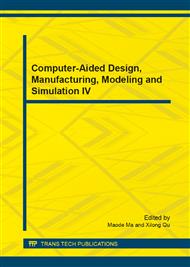[1]
P.F. Pai, W.C. Hong. Forecasting regional electricity load based on recurrent support vector machines with genetic algorithms. Electric Power Systems Research, 2005, 74(3): 417–425.
DOI: 10.1016/j.epsr.2005.01.006
Google Scholar
[2]
P.F. Pai, W.C. Hong. Support vector machines with simulated annealing algorithms in electricity load forecasting. Energy Conversion and Management. 2005, 46(17): 2669–2688.
DOI: 10.1016/j.enconman.2005.02.004
Google Scholar
[3]
B.J. Chen, M.W. Chang, C.J. Lin. Load forecasting using support vector machines: a study on EUNITE competition 2001. Transactions on Power System. 2004, 19(4) : 1821-1830.
DOI: 10.1109/tpwrs.2004.835679
Google Scholar
[4]
Shuying Wang, Weiming Shen, Qi Hao, An agent-based Web service workflow model for inter-enterprise collaboration, Expert Systems with Applications 31 (2006) 787–799.
DOI: 10.1016/j.eswa.2006.01.011
Google Scholar
[5]
Minhong Wang, Huaiqing Wang, Dongming Xu, The design of intelligent workflow monitoring with agent technology, Knowledge-Based Systems 18 (2005) 257–266.
DOI: 10.1016/j.knosys.2004.04.012
Google Scholar
[6]
Z.Y. Wang, Y.J. Cao. Mutual information and non-fixed ANNs for daily peak load forecasting. Power Systems Conference and Exposition. 2006, 5(2): 1523-1528.
DOI: 10.1109/psce.2006.296526
Google Scholar
[7]
Farahat M.A. Long-term Industral Load Forecasting and Playing Using Neural Networks Technique and Fuzzy Inference Method. Energy Policy. 2005, 33(8): 368-371.
Google Scholar
[8]
Boukary Ouedraogo. Household energy preferences for cooking in urban Ouagadougou Burkina Faso. Energy Policy. 2006, 34(18): 3787-3795.
DOI: 10.1016/j.enpol.2005.09.006
Google Scholar
[9]
Pernille Holtedahl, Frederick L. Joutz . Residential electricity demand in Taiwan. Energy Economics. 2004,26(2): 201-224.
DOI: 10.1016/j.eneco.2003.11.001
Google Scholar
[10]
Bente Halvorsen Bodil M. Larsen. The flexibility of household electricity demand over time. Resource and Energy Economics. 2001, 23(1): 1-18.
DOI: 10.1016/s0928-7655(00)00035-x
Google Scholar
[11]
Kyung-Bin Song, Seong-Kwan Ha. Hybrid load forecasting method with analysis of temperature sensitivities. Transactions On Power Systems. 2006, 21(2) : 869-877.
DOI: 10.1109/tpwrs.2006.873099
Google Scholar
[12]
Kyung-Bin Song, Young-Sik Baek, Dug Hun Hong etal. Short-Term Load Forecasting for the Holidays Using Fuzzy Linear Regression Method[J]. Transactions on Power Systems. 2005, 20(1): 96-102.
DOI: 10.1109/pes.2005.1489152
Google Scholar
[13]
Xiaoli Li, Chris P. Bowers, Thorsten Schnier. Classification of Energy Consumption in Buildings with Outlier Detection. , IEEE Transactions on Industrial Electronics, 2009, pp(99): 1-6.
DOI: 10.1109/tie.2009.2027926
Google Scholar
[14]
Jiawei Han, Micheline Kamber. Data Mining: Concepts and Techniques, Second Edition, Beijing: China Machine Press, 2006. 4: 291-310.
Google Scholar
[15]
Roman Timofeev. Classification and Regression Trees (CART) Theory and Applications, Master Thesis, Humboldt University, Berlin, 2004. 12.
Google Scholar
[16]
K. Yamanishi, J. Takeuchi. Discovering outlier filtering rules from unlabeled data. Conference on Knowledge Discovery and Data Mining, 2001: 389–394.
DOI: 10.1145/502512.502570
Google Scholar


